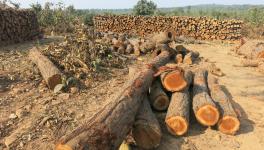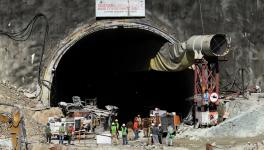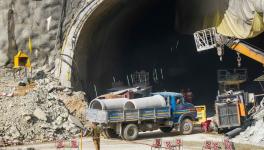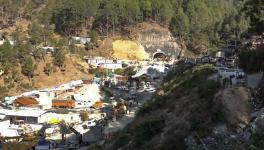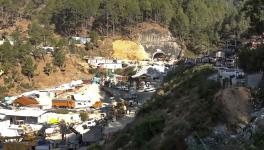India Ignores Experts to Build Expressway in Fragile Himalayas
If Covid-19 has brought home one fact, it is the importance of trees and forests in containing any outbreak. And yet our hill states, led by Uttarakhand, have taken axed thousands of trees, the lifeline of any hill state.
The latest brainwave of the Ministry of Road Transport and Highways is to build a Delhi-Dehradun express highway that will reduce the driving time between them to less than three hours. To achieve this dubious objective, the beautiful forests along the foothills of the Shivalik range will need to cleared for road-widening. Thousands of old Sal trees planted over 150 years ago will be felled. Over two thousand Cheer, Sagun, Peepul, Mango, Gulmohar and Blackberry trees are also going to be axed, among hundreds of other tree varieties.
This project has been described as dubious because the Meerut-Muzaffarnagar bypass has already reduced the driving time between Delhi and Dehradun to four hours. Besides, there is air connectivity between both the cities, which reduces the travel time to two hours including the time spent in security check. Increased train connectivity also ensures that a middle-income traveller can bridge the distance in five hours. Then why is there a tearing hurry to destroy one of the few green belts? Trees in the Rajaji Tiger Reserve play a vital role in preventing soil erosion and are a safe haven to wildlife including the tigers, leopard and elephant.
The cost of this express-way will be more than Rs.10,000 crore and bureaucrats in the Ministry of Road Transport believe they will recover this money from enhanced tourism even though the Covid-19 pandemic has brought tourism to a complete halt at the moment.
The Garhwal Himalaya has already seen large-scale deforestation. The ambitious “Char Dham Pariyojana” all-weather road is expected to four-lane the route to four pilgrimage centres at Kedarnath, Badrinath, Yamunotri and Gangotri. Already one lakh trees are said to have been felled for this (although the official figure is lower). Several species of Silver Oak, Pine and Deodar have been cut down to facilitate the widening of this road.
This deforestation is the reason why landslides are taking place at greater frequency along these roads, at gaps of roughly every 10 km. Over 10,000 trees have been chopped in the Rudraprayag forest division alone, which faced immense ecological losses during the 2013 flash floods in Kedarnath and adjoining areas, and in which over 5,000 people died.
The Char Dham project should have proceeded with great caution especially as it passes through 529 landslide-prone areas, but it is being built without the mandatory Environmental Impact Assessment clearances. Neither the Ministry of Environment and Forests nor the state government conducted any detailed cumulative assessment of the impact of this project on this ecologically sensitive region in the catchment area of the Ganga.
Dr. Ravi Chopra, former director, People’s Science Institute, Dehradun, says that this area forms the central thrust region of the lesser Himalayan region. “This is where the Indian tectonic plate goes under the Eurasian tectonic plate, making the entire region susceptible to earthquakes and landslides,” he says.
The Geological Survey of India makes exactly the same point when it states that road construction in the mountains reactivates landslides as it disturbs the “toe of the natural slope of the hill”.
In an attempt to contain this loss, Chopra, who was chairman of a Supreme Court-appointed High Powered Committee on the Char Dham highway, along with four other members, all specialists, have suggested that the road be restricted to a width of 5.5 metres, with a final width of 7 to 8 metres. But the remaining 21 members of the committee, who are largely government officials including eight district magistrates, have insisted that the original width of 12 metres should be retained. It is common knowledge that Prime Minister Narendra Modi is keen on early completion of this four-lane highway.
Surprisingly, Chopra’s stand has been corroborated by none other than the Ministry of Road Transport, which in a 2018 circular had stated that a 12-metre wide road is not suitable for the terrain of this hilly region.
The 21 members of the team argued that this road has strategic value, and hence if it is wider it would allow uninterrupted and speedy movement of defence equipment. But Chopra refutes this reasoning, saying, “When the military moves, it moves in a single column—remember Pulwama?”
Another equally controversial project is the rail link between Rishikesh and Karnaprayag , also being built to boost tourism. This will require even more trees to be cut. If the Charm Dham road can cost up to Rs. 13,000 crore, the rail link will cost around Rs.18,000 crore, a big jump from the Rs.4,000 crore in the original proposal eight years ago.
This controversial rail link was not cleared by the Uttarakhand state environment ministry for several years because it was convinced the track alignment plan was not linear, which is a mandatory requirement to protect the fragile Himalayas. But the Centre gave it the go-ahead and this rail link will have 16 bridges and a large number of tunnels including one that will be 15.8 kilometres long. The railway project will also not have to go through an Environment Impact Assessment.
Speaking on condition of anonymity, a project manager said they had already received a large tract of land on which the forest has to be cleared. It is the acquisition of private land which was creating an impediment. This manager warns that in order to “get past these fragile mountains, most of the railway link would consist of large underground tunnels.”
Activists warn that such extensive tunnelling will generate large quantities of mud and soil waste, for which there is no proper means of disposal. This is a critical question considering that the maximum damage of the 2013 Uttarakhand deluge was due to these unattended mounds of mud.
SP Sati, a geologist with the University of Horticulture and Forestry, Tehri, says that the consequences are already visible. “This year the monsoon has come with heavy landslides along the Alaknanda and Tehri routes with thousands of trees uprooted due to mudslides,” he says. The Badrinath road has been closed for three weeks.
“Dumping sites [for the waste mud] are nothing but eyewash. Huge quantities of muck are flowing into these river basins. They are now trying to build retaining walls on the upper side, but given the heavy rainfall, there is every likelihood the walls will not hold,” Sati rues.
Om Prakash, the new chief secretary of Uttarakhand responds to these concerns by pointing to the Nainital High Court order that muck disposal points have to be created 500 metres from the site of construction. “This is not possible given the existing terrain,” he says. “Where will we find the land to create this [disposal points]?”
However, Prakash supports the 21 members of the High Power Committee on the four-laning of the Char Dham route. He maintains that since that road would lead up to the Indo-China border, and is used by security forces, it must be broadened. “Just to take the Bofors gun of 12 metres up to the border we need a [adequate] carriageway, and there is no way that the road construction can be blocked,” he says.
He says that the expansion of the road is proceeding along scientific lines, which will ensure slope stabilisation. He also says that four-laning is important since Uttarakhand depends heavily on tourism for revenues and employment.
Mallika Bhanot, a member of Ganga Ahvaan, a group that opposes dams on the Ganga, warns cutting hill slopes to build roads and rail links will only aggravate the rapid environmental degradation of these already fragile hillsides. Dr Vaidya, an environmental ecologist at the Jawaharlal Nehru Centre for Advanced Scientific Research, Bengaluru, says the construction activity being undertaken is not paying adequate attention to the unique geological and hydrological features of the lower Himalaya region. Vaidya warns of roads being constructed along seismic fault lines in this earthquake-prone state. Construction on fault-lines can weaken the rocks at the base of roads, making parts of it susceptible to cave-ins and landslides, as is being witnessed.
Environmental lawyer Sanjay Parikh, who was one of the petitioners against this road expansion in the Supreme Court, says, “Mountain slopes along the sides of the roads are being cut at 90-degree angles, whereas it should be done at 45 degrees. Mountain slopes help restrain the flow of water, but if cut improperly, the water could get onto the roads.”
Even cities are not being spared in this frenzy of tree-cutting and the timber mafia is undoubtedly behind the sparse cover getting axed at an alarming rate, all in the name of infrastructure development.
Dehradun-based Sanjeev Srivastava, a member of Friends of Green Doon and other environmentalists are fighting against all odds to ensure that the old trees which give Dehradun its unique ambience are not felled for these projects.
“From Ghantaghar in the centre of town to Prem Nagar [across the city], Dehradun PWD has chopped all the trees on either side of the Chakrata road. These have not been replaced to this day. They now plan to cut down 38 old trees between Survey Chowk and Raipur Chowk. We have launched a movement to save the 100-year-old trees growing here. They also plan to cut down another 1,400 trees along the Sahasradhara road to widen the road. We need much more people’s support on the ground for this fight,” says Srivastava.
Aanchal Sondhi, who runs the NGO, Titli, regrets that the Forest Department is too weak-kneed and unable to stand up to the diktats of the Mussoorie Dehradun Development Authority, the PWD and the Dehradun Municipal Corporation, who are riding roughshod over them.
The fundamental issue is that the government at the state and the Centre do not pay any heed to experts. This flawed logic has led the Ministry of Environment and Forests to approve a Zonal Master Plan for the Bhagirathi Eco-Sensitive Zone (BESZ) as well. This change in status will destroy the last pristine green belt in the Garhwal Himalaya. The state government had from the start opposed the BESZ, which disallowed industries or hydel power stations in the area, which it described as “anti-development”. Four-laning the Char Dham road has found a perfect excuse in catering to defence and tourism needs, but all this environmental loss will in the end bring more harm than good.
The author is a freelance journalist. The views are personal.
Get the latest reports & analysis with people's perspective on Protests, movements & deep analytical videos, discussions of the current affairs in your Telegram app. Subscribe to NewsClick's Telegram channel & get Real-Time updates on stories, as they get published on our website.









